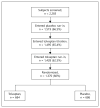Rationale and Design of a Clinical Trial Investigating Tolvaptan Safety and Efficacy in Autosomal Dominant Polycystic Kidney Disease
- PMID: 28166521
- PMCID: PMC5497717
- DOI: 10.1159/000456087
Rationale and Design of a Clinical Trial Investigating Tolvaptan Safety and Efficacy in Autosomal Dominant Polycystic Kidney Disease
Abstract
Background: In TEMPO 3:4, the vasopressin V2-receptor antagonist tolvaptan slowed kidney growth and function decline in autosomal dominant polycystic kidney disease (ADPKD) patients with relatively preserved kidney function.
Methods: Prospective, phase 3b, multi-center, randomized-withdrawal, placebo-controlled, double-blind trial of tolvaptan in ADPKD patients with late stage 2 to early stage 4 chronic kidney disease (CKD). The primary endpoint was estimated glomerular filtration rate (eGFR) change from pre-treatment baseline to post-treatment follow-up. Secondary endpoints included annualized eGFR slope, incidence of ADPKD complications, and overall and hepatic safety profiles. Participants were 18-55 year-old ADPKD patients with baseline eGFR ≥25 and ≤65 mL/min/1.73 m2 or 56-65 year-old with eGFR ≥25 and ≤44 mL/min/1.73 m2 and evidence of eGFR decline >2.0 mL/min/1.73 m2 per year. Daily split doses of tolvaptan were titrated to tolerance (30/15, 45/15, 60/30, or 90/30 mg) and maintained for 12 months, after an 8-week pre-randomization period to screen out subjects unable to tolerate at least 60/30 mg for 3 weeks.
Results: Of 1,495 subjects who entered the tolvaptan titration period, 125 (8.4%) discontinued the study before randomization. One thousand three hundred seventy subjects (684 tolvaptan, 686 placebo) from 213 centers across 21 countries were randomized. Baseline demographics were well balanced across treatment arms. Information collected during the study included eGFR, survey scores (PKD history and outcome), adverse events, vital signs, hematology, urinalysis, and serum chemistry tests.
Conclusion: Replicating Evidence of Preserved Renal Function: An Investigation of Tolvaptan Safety and Efficacy (REPRISE) determines whether tolvaptan administered over 1 year exhibits disease-modifying properties in ADPKD patients with late stage 2 to early stage 4 CKD, which provides an important therapeutic advancement for this difficult-to-treat disease.
© 2017 S. Karger AG, Basel.
Figures
References
-
- Torres VE, Harris PC, Pirson Y. Autosomal dominant polycystic kidney disease. Lancet. 2007;369:1287–1301. - PubMed
-
- Grantham JJ. Clinical practice. Autosomal dominant polycystic kidney disease. N Engl J Med. 2008;359:1477–1485. - PubMed
-
- Hughes J, Ward CJ, Peral B, Aspinwall R, Clark K, San Millan JL, et al. The polycystic kidney disease 1 (PKD1) gene encodes a novel protein with multiple cell recognition domains. Nat Genet. 1995;10:151–160. - PubMed
-
- Polycystic kidney disease. the complete structure of the PKD1 gene and its protein. The International Polycystic Kidney Disease Consortium. Cell. 1995;81:289–298. - PubMed
-
- Mochizuki T, Wu G, Hayashi T, Xenophontos SL, Veldhuisen B, Saris JJ, et al. PKD2, a gene for polycystic kidney disease that encodes an integral membrane protein. Science. 1996;272:1339–1342. - PubMed
Publication types
MeSH terms
Substances
Grants and funding
LinkOut - more resources
Full Text Sources
Other Literature Sources
Medical
Research Materials
Miscellaneous



